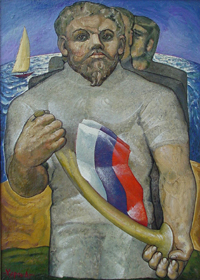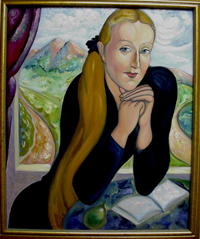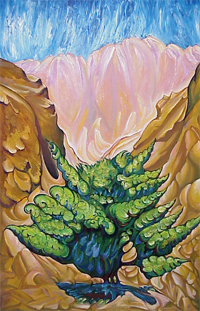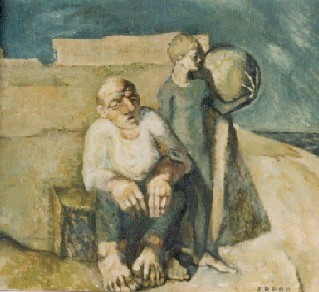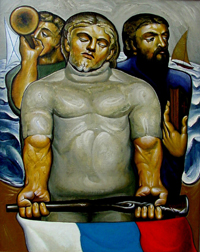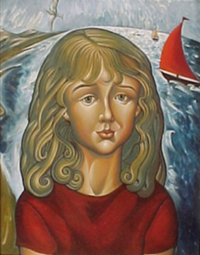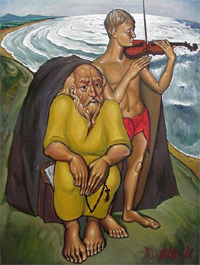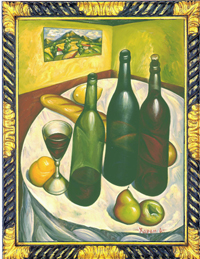Ключ к познанию искусства Византии.
«Дух европейский победить не может великой византийской красоты».
Схиигумен Авраам (Рейдманд).
Старец - Наставник.
«Мельница мелит, а мельник зерно в неё бросает – трудиться. Так мука получается, из которой хлеб печётся. Это подобно тому, как человек в церкви стоит службу слушает и Богу молиться, а потом радость неизреченная бывает». Старец Андрей (Машков).
Православное Богословие и история происхождения иконографии.
Orthodox Theology and History of The Origin of Iconography.
By Иконописец Александр Харон.
By Aleksandr Kharon, Orthodox Iconographer.
Coloring:
Purple represents prayer.
Blue is the words of the Gospel.
Red is the words of the Holy Fathers from the Canon.
This explains interpretation of the canon of the Holy Fathers.
Black is commentary by Aleksandr Kharon.
Господи Иисусе Христе, Сыне Божий, помилуй нас и огради от всякого зла молитвами Богородицы и всех святых Твоих в иконографии прославившие Твой Святой Образ, молитвами духовного отца нашего игумена Андрея, благослови на святое дело сие во славу Твою, Единосущного Бога в Трёх Ипостасях.
Lord Jesus Christ, Son of God, have mercy on us and save us from evil, by prayer of the Mary-Theotokos, and your Saints, in iconography glorify Your Holy Image, and for prayer my spiritual father abbot Andrew, please bless our holy duty here for Your glory, Common-Nature of the God in the Trinity.
Note: Единосущного means consubstantial, or “Ofthesamekindornature or substance”, and is translated as Common-Nature, and ТрёхИпостасях, literally “the Three-Persons”, is the Trinity.
В начале было Слово, и Слово было у Бога, и Слово было Бог. Оно было в начале у Бога. Все чрез Него начало быть, что начало быть. В Нем была жизнь, и Жизнь была свет человеков. И Свет во тьме светит, и тьма не объяла Его. (От Иоанна Святое Благовесвование. Глава 1, 1-5. )
Был Свет истинный, который просвещает всякого человека, грядущего в мир. ( Глава 1, 9. )
И Слово стало плотию, и обитало с нами, полное благодати и истины; и мы видели славу Его,славу, как Единородного от Отца. Бога не видел никто никогда; Единородный Сын, сущий в недре Отчем, Он явил. ( Глава 1, 14 и 18. )
In the beginning was the Word, and the Word was with God, and the Word was God. This One was in the beginning with God. All things came into being through Him, and without Him not even one thing being that hath come to be. In Him was life; and the Life was the light of men. And the Light shineth in the darkness, and the darkness overcame it not Him. (John 1:1-5) That was the true Light, which giveth light to every man coming into the world. (John 1:9) And the Word became flesh, and tabernacled among us, and we beheld His glory, the glory as of an Only-begotten from the Father, full of grace and truth. (John 1:14) No one hath seen God at any time. The Only-begotten Son, Who is in the bosom of the Father, that One declared Him. (John 1:18)
Иконография–есть проявление любви Бога к человечеству потому, что Сын Божий воплотился и вочеловечился, значит стал зрим, осязаем, оприсуем. И мы через воплощение Сына Божия получили благословение Божие изображать священную историю Ветхого и Нового Завета. Весь мир философский недоумевал, как Сын Божий (Един сый Святыя Троицы ), воплотился и вочеловечился (ни ходатай ни ангел, но Сам Господи воплощься ). Единосущный Отцу и Духу стал одно с иносущной Богу, с тварной, конечной и смертной человеческой природой.
Iconography reveals the love of God for humanity. Because the Son of God in creation became human, and can be seen by everyone, can be touched, and we can write about Him. And, from the Son of God’s creation, we take God’s blessing when we make images of holy history, the Old Testament and the New Testament. All of the philosophers of the world don’t understand how this happened, how the Son of God (One bosom from the Holy Trinity), became human (not as an intercessor, not as an angel, but Himself the Lord in creation). The One Common-Nature of the Father and Holy Spirit become one with another from the God nature: with the creation, with the ending, with the death human nature.
Единосущный(One-common-nature) c ( with) Отцу (Father) и (and) Духу (Spirit) стал (become) одно (one) с (with) иносущной ((adj. For God) another nature) Богу (God), с (with) тварной (the god creator become the creation), конечной ( ending-termination) и (and) смертной (death) человеческой(human) природой (nature).
Да, эллинский метафизический гений, после длительной болезни, стучался в дверь тайн христианского ( Богом данным ) откровения.
Yes, the old Greek metaphysical geniuses, after a long sickness, knock on the door of the secret Christianly (God given) revelation.
Триодологический догмат христианской веры составленный право-славными святыми отцами участниками(I-го Никейского 325 года, и II-го Константинопольского 381-го года) Вселенских соборов.
Александрийская богословская школа во главе с Александром патриархом Александрийским и архидиаконом Афанасием Великим
(ставшим в последствии патриархом) твёрдо отстаивала Едино-сущность природы Сына Божия Единосущности природе Отца.
Василий Великий богословствующий, во главе отцов Каппадокийцев в 370-м году составил отчётливую формулу основного догмата кафолической православной христианской веры о взаимоотношении Единосущной Божественной природы и Трёх Ипостасях. Различие Лиц Святой Троицы при Единосущной Божественной природе.
Doctrine of the Holy Trinity of Christian faith was composed by the orthodox holy fathers who participated in the the I ecumenical councils of Nicaea in 325 A.D., and II Constantinople 381 A.D.. Alexandrian theological school, led by Patriarch Aleksandr of Alexandria and archdeacon Afanasiy the Great (he became Patriarch after the death of Aleksandr), strongly defended the united essence of the nature of the Son of God the consubstantiation, same nature, of the father.
Basil the Great, writing theology as the head of the Kappadocian fathers, in 370 A.D., composed the pure basic doctrine of the universal orthodox Christian belief about the relationship of the unity of the Godly nature and the three persons of the Trinity: This was the differentiation of the persons in the Holy Trinity and the consubstantiation, or same nature, of the Godly nature.
,,Отец есть имя Божие не по сущности и не по действию, но по отношению, какое имеет Отец к Сыну или Сын к Отцу.” Отец (больше) Сына по причастности и равен по природе.
,,Сын рождается из ипостаси Отца и Дух исходит из ипостаси Отца.”
“Father is the name of the Divine God, not by nature, and not by duty, but according to the relationship between the Father to Son or Son to Father.” Father (big) Son by participation and equality of nature.
“Son was born from the person of the Father and Spirit comes from the person of the Father.”
Вот, это изящно тонкое объяснение, и составляет гениальное философско – богословское достижение не только каппадокийской школы, но всего христианства единого: восточного и западного.
Here, this is a very elegant explanation, and builds a brilliant philosophical explanation – the theological achievement not only of the Kappadocean school, but of all Christianity united: east and west.
Второй основной - христологический догмат-орос был выработан святыми отцами Церкви Христовой и утверждён Духом Святым на
IV-м Халкидонском Вселенском соборе.
The second basic Christian doctrine-oros was developed by holy fathers of the Christian Church, and established by Holy Spirit, on the IV-fourth Ecumenical Council in the Khalkidon.
Постановление святых отцов IV-го Вселенского собора 451-го года в Халкидоне гласит, что в Одном Господе Иисусе Христе, Сыне Божием, взаимодействуют две цельные природы: Божественная и человеческая, которые таинственно пребывают неслитно,непревра-щенно, неразделимо, неразлучимо.
Decision of the Holy Father’s IV Ecumenical Council in 451-A.D. in Khalkidon announce that in One Jesus Christ, Son of God two solid nature cooperate: Divine and human which mystery exist not-mixed, inseparably, indivisibly, inconvertibly.
Поклонение образу человеческой природы Господа Иисуса Христа возносится к Первообразу – Сыну Божию вочеловечшемуся.
Поэтому иконописание издревна называлось на Руси святым делом, а иконописца называли богословом, в простонародии Бого-мазом.
Worship to the image of human nature of the Lord Jesus Christ ascent to Prototype – Son of God who was incarnated. Therefore iconography from the earliest time was named in Russia holy work and iconographer was named theologian, in the people called God-painter.
Поскольку иконописец изображает человеческую природу Иисуса Христа Спасителя нашего, постольку он уловляет Благодать изоб-разить Божественную природу, Единосущную Отцу Сына Божия.
На VII Вселенском соборе в 787м году,в городе Никеи было восстановленно и утвержденно почитание святых икон, а иконоборчество предано анафеме. ( Как одно из проявлений монофизитской ериси).
So far as iconographer portrays human nature of Jesus Christ to that extent he catches grace to portray God nature which is consubstantial to Father, Son of God. On VII Ecumenical Council in 787 year in Nikea was recollected and established glorification of Holy icons but iconoclasm was omitted to anaphema-not with as. (As one of the manifestation of mono-physic heresy.)
Церковь установила празднование иконопочитания в день Торжества Святого Православия, в первое Воскресенье Великого поста.
Church established celebration of icons-worship in the “Celebration of the Holy Orthodoxy,” in the first Sunday of the Great feast.
Иконописание – это богословие в красках ( пишет святой Иоанн Дамаскин в двух письмах в защиту иконографии от иконоборчес-кой ереси), окно в Царство Небесное, дверь в горнее, ключ в Рай.
В иконе всё исторически символично: cюжет, композиция, перспектива, рисунок, цвет, свет, процесс написания риз (тоесть всего доличного ), и конечно же ликов и всех телесных частей ( тоесть всего личного ).
Так например: ,,Санкирь” - символизирует таинственность, непознаность Божественной природы, “Сарка” – по гречески плоть, символизирует воплощение и вочеловечение Сына Божия.
Вохрение (по славянски высветление цветом охры) символизирует Фаворский Божественный Свет (учение Григория Паламы о Фаворском Свете), и “Оживки” символизируют видимое действие Духа Святаго.
Iconography is theology in painting (written by John of Damask in two letters for protection from iconoclasmical heresy), window to the Kingdom, door to the highest, key to the paradise. In the icon everything is mystical symbolic: subject, composition, perspective drawing, color, light, process of painting cloth, (not sein, face (everything must be done before the face)) of course holy faces and all of the body skin part.
For example: “Sankir” – symbol of mystery of unknown God nature, “Sarka” – in Greek is flesh symbol of incarnation Son of God.
Vokhrenie is symbol of the Tabor Divine Light (teaching of Gregory Palamas about Tabor light), and “Ozivky” symbol of Resurrection represent of mystery of Holy Spirit.
Все процессы написания иконы, принадлежат к личному духовно- художественно-эстетическому знанию и мастерству иконописца.
All processes of painting icons belong to personal spirit, artistic, aesthetical knowledge and skill of the iconographer.
Например: прокладка “Болюса” по написанным телесным местам значительно притепляет контурную линею и санкирь. Дионисий из Фурны в своём трактате об иконописании -“Ерминия” пишет, что болюс нанесённый на санкирь делает его сладким.
For example: laying of “Bolus” makes Sankir, warm and sweet. Deonisian from Forna in his writing about iconography “Erminia” writings, what layer (bolus) on top of sankir makes him sweet.
Плавка помогает плавно перейти от холодного тёмно-зелёного-санкира к тёплой телесной сарке. Каждый процесс наносится кистью активно, по форме от внутреннему рисунку и подбивается, притирается к большой форме, к контурной линий прорези-рисунка.
Каждый слой не смешивают с предыдущим, а притирают к краям.
Plavka helps transform from dark-green-sankir to warm flesh-sarka. Each process of painting icon should be active from inside drawing and blend to contour line. Every layer is not to be mixed with the previous layer, instead it is to be placed on top of the previous layer after the previous layer is dried. In some places, the icon may need 15 layers, and because of this there will be a noticeable relief, or 3 dimensional contour, to features of the icon, such as the fingers, the nose, and around the eyes.
И так, в иконографии мы используем весь творческий опыт человечества для прославления в Троице Единого Бога и святых его.
В Ветхом Завете,на горе Синайской, великому пророку Моисею Бог Отец открыл Сына Своего, Бога Слова, затем через Сына в купине горящей и не сгорающей дал закон на двух скрижалях. И Господом Богом Духом Святым стало выженно десять заповедей Божиих. Потом, повелел Господь Моисею устроить скинию - переносной храм Божий, образ которого Он описал Словом Своим Святым. Моисей сделал всё, что повелел ему Единый в Троице Господь Бог. Так иконописец должен поступать, из любви к Господу Богу Иисусу Христу, почитая Ветхий и Новый Завет в толковании святых отцов.
So in iconography, we use our creative experience of all humanity for glorification in Trinity of One God and all His saints. In the Old Testament on Mount Sinai to the great prophet Moses, God open His Son, God of Word, then by his Son in Burning Bush, but not burned to the end, and gave the Ten Commandments on two stones. (And the Lord God Holy Spirit become the fire ten commandments on the stone tablets.) Then God commanded Moses to build the Ark of the Covenant, to hold the image of his Holy Word. God give all the dimensions and detailed instructions about the decorations for the ark, the special materials, and Moses created it according to the word of God. Moses did everything that he was commanded by the One in the Three Persons (Ipostacy), Trinity God. So, iconographer must do icons from his love of the Lord God Jesus Christ, and have a great respect of the Old and New Testaments in the interpretation of the holy fathers.
СЛАВА БОГУ ЗА ВСЁ . АМИНЬ .
GLORY TO GOD FOR EVRYTHING. AMEN.
Пасхальная Суббота 2003 год. Иконописец Александр Харон.
Easter-Passover Saturday 2003 y. Iconographer Aleksandr Kharon,
